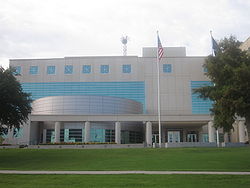Bossier Parish is located in northwest Louisiana on the east bank of the Red River and sharing a northern border with Arkansas. Bossier Parish was created in 1843 by Act 33 of the Louisiana Legislature and signed by Governor Alexander Mouton. Mouton, a Georgetown educated lawyer turned sugar planter, was Louisiana's 11th governor. The parish was named after Louisiana's militia general at the time, Pierra Evansite John Baptiste Bossier. Bossier was elected to congress from this district the same year Bossier Parish was created. Bossier Parish was created out of Claiborne Parish. The parish originally developed through the cotton and slave trade until the Civil War. After the war, much of the Parish's development can be attributed to the numerous oil fields found in the area.
Arkansas. Bossier Parish was created in 1843 by Act 33 of the Louisiana Legislature and signed by Governor Alexander Mouton. Mouton, a Georgetown educated lawyer turned sugar planter, was Louisiana's 11th governor. The parish was named after Louisiana's militia general at the time, Pierra Evansite John Baptiste Bossier. Bossier was elected to congress from this district the same year Bossier Parish was created. Bossier Parish was created out of Claiborne Parish. The parish originally developed through the cotton and slave trade until the Civil War. After the war, much of the Parish's development can be attributed to the numerous oil fields found in the area.
Bossier Parish is the fastest growing parish in Louisiana. In 1840 the population was 7,000 and by 2000 had grown to 100,000. This surge of population is primarily due to the growth of Bossier City. However, the parish seat is not Bossier City but a much smaller town of just 2,000 residents; Benton. Bossier Parish's first parish seat was Freedonia (later renamed Society Hill and again Bellevue). In the late 1800s, Bellevue's courthouse partially burned. Due to the lack of railroad in Bellevue an election was held by the Police Jury of the parish to rebuild the courthouse in a new parish seat, closer to the railraod. Though the election favored the town of Benton, the Police Jury was disgruntled and refused to meet and carry on with protocol to move the seat. Finally, in 1888 a group of parish citizens snuck into the Bellevue courthouse and transported the remaining parish records to Benton. Finally, the Police Jury met and authorized the construction of a new courthouse.
Benton and Bossier City both have preserved many buildings and have several structures on the National Historic Register. Bossier Parish also has several protected natural areas such as part of the Red River National Refuge, Lake Bistineau State Park and Loggy Bayou Wildlife Management Area. As one of the last remaining bottomland, hardwood areas in Northwest Louisiana, Loggy Bayou is of great importance to protect.